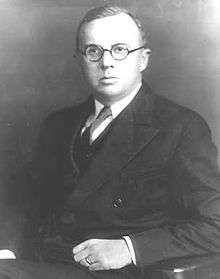Sanford Bates
Sanford Bates (July 17, 1884 in Boston, Massachusetts – September 8, 1972) was an American politician and public administrator who served as the first Director of the Federal Bureau of Prisons (1930–1937), a subdivision of the United States Department of Justice.[6]
Sanford Bates | |
|---|---|
 Sanford Bates, c. 1930s | |
| Member of the Massachusetts House of Representatives 24th Suffolk District[1] | |
| In office 1912[2] – 1914[2] | |
| Delegate to the 1917 Massachusetts Constitutional Convention[3] | |
| In office June 6, 1917[4] – 1919[5] | |
| Personal details | |
| Born | July 17, 1884 Boston, Massachusetts[1] |
| Died | September 8, 1972 (aged 88) |
| Political party | Republican[1] |
| Alma mater | Boston English High School, Y.M.C.A. Evening Law School[1] |
| Profession | Attorney[1] |
Education
Bates attended Boston public schools graduating from English High School,[1] and from the Y.M.C.A. Evening Law School, now Northeastern University.[1][7]
Early career
Before he became an attorney, Bates worked as a clerk in the Boston Street Department.[1]
Political career
Early in his career Bates was active in the local Republican party, he was a member of the Lincoln club, the Republican club of Boston's Ward 24, serving as a member of the Ward 24 Republican Committee in 1910-1911.[1]
Legislative career
Bates served in both houses of the Massachusetts General Court (1912-1917). From 1912 to 1914[2] Bates represented the 24th Suffolk District in the Massachusetts House of Representatives.[1] From
1917 Massachusetts Constitutional Convention
In 1916, the Massachusetts legislature and electorate approved a calling of a Constitutional Convention.[4] In May 1917,[4] Bates was elected to serve as a member of the Massachusetts Constitutional Convention of 1917, representing the 19th Suffolk District.[3] Bates was a member of the Convention's Committee on Liquor Traffic.[8]
Corrections career
On November 1, 1918 Bates was appointed as the Commissioner of Penal Institutions in Boston (1917-1919),[2] then appointed as Commissioner of the Massachusetts Department of Corrections in 1919 by then-Governor Calvin Coolidge. Bates served there until 1929 when he became the first Superintendent of Prisons for the newly created Federal Bureau of Prisons, U.S. Department of Justice, through January 31, 1937.[9] From 1945 until his semi-retirement in 1954 he headed yet another prison system, the New Jersey Department of Corrections.
Among many other titles, positions and honors, Bates was the president of the American Prison Association in 1926.
References
- Who's Who in State Politics, 1912, Boston, MA: Practical Politics, 1912, p. 108.
- Bridgman, Arthur Milnor (1919), A Souvenir of the Massachusetts Constitutional Convention, Boston, Stoughton, MA: A. M. (Arthur Milnor) Bridgman, p. 60.
- Journal of the Constitutional Convention of the Commonwealth of Massachusetts. Boston, MA: Wright & Potter printing co., state printers. 1919. p. 12.
- Journal of the Constitutional Convention of the Commonwealth of Massachusetts. Boston, MA: Wright & Potter printing co., state printers. 1919. p. 7.
- Bridgman, Arthur Milnor (1919), A Souvenir of the Massachusetts Constitutional Convention, Boston, Stoughton, MA: A. M. (Arthur Milnor) Bridgman, p. 67.
- "Sanford Bates Collection, 1906-1972" SHSU Special Collections & University Archives. Retrieved 2015-2-22.
- Mcshane, M. (1 February 1996). Encyclopedia of American Prisons. Taylor & Francis. pp. 82–. ISBN 978-0-8153-1350-2. Retrieved 7 September 2012.
- Bridgman, Arthur Milnor (1919), A Souvenir of the Massachusetts Constitutional Convention, Boston, Stoughton, MA: A. M. (Arthur Milnor) Bridgman, p. 25.
- "Former Bureau of Prisons Directors". Bureau of Prisons. Archived from the original on 15 September 2012. Retrieved 8 September 2012.